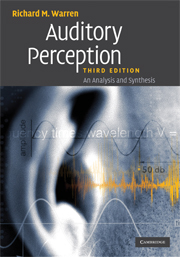Book contents
- Frontmatter
- Contents
- Preface
- 1 Sound and the auditory system
- 2 Spatial localization and binaural hearing
- 3 Perception of acoustic repetition: pitch and infrapitch
- 4 Judging auditory magnitudes: the sone scale of loudness and the mel scale of pitch
- 5 Perception of acoustic sequences
- 6 Perceptual restoration of missing sounds
- 7 Speech
- 8 The relation of hearing to perception in general
- References
- Index
5 - Perception of acoustic sequences
Published online by Cambridge University Press: 18 May 2010
- Frontmatter
- Contents
- Preface
- 1 Sound and the auditory system
- 2 Spatial localization and binaural hearing
- 3 Perception of acoustic repetition: pitch and infrapitch
- 4 Judging auditory magnitudes: the sone scale of loudness and the mel scale of pitch
- 5 Perception of acoustic sequences
- 6 Perceptual restoration of missing sounds
- 7 Speech
- 8 The relation of hearing to perception in general
- References
- Index
Summary
The comprehension of speech and the appreciation of music require listeners to distinguish between different arrangements of component sounds. It is often assumed that the temporal resolution of successive items is required for these tasks, and that a blurring and perceptual inability to distinguish between permuted orders takes place if sounds follow each other too rapidly. However, there is evidence indicating that this common-sense assumption is false. When components follow each other at rates that are too rapid to permit the identification of order or even the sounds themselves, changes in their arrangement can be recognized readily. This chapter examines the rules governing the perception of sequences and other stimulus patterns, and how they apply to the special continua of speech and music.
Rate at which component sounds occur in speech and music
Speech is often considered to consist of a sequence of acoustic units called phones, which correspond to linguistic units called phonemes (the nature of phonemes will be discussed in some detail in Chapter 7). Phonemes occur at rates averaging more than 10 per second, with the order of these components defining syllables and words. Conversational English contains on average about 135 words per minute, and since the average word has about 5 phonemes, this corresponds to an average duration of about 90 ms per phoneme (Efron, 1963). It should be kept in mind that individual phonemes vary greatly in duration, and that the boundaries separating temporally contiguous phonemes are often not sharply defined.
- Type
- Chapter
- Information
- Auditory PerceptionAn Analysis and Synthesis, pp. 126 - 149Publisher: Cambridge University PressPrint publication year: 2008



